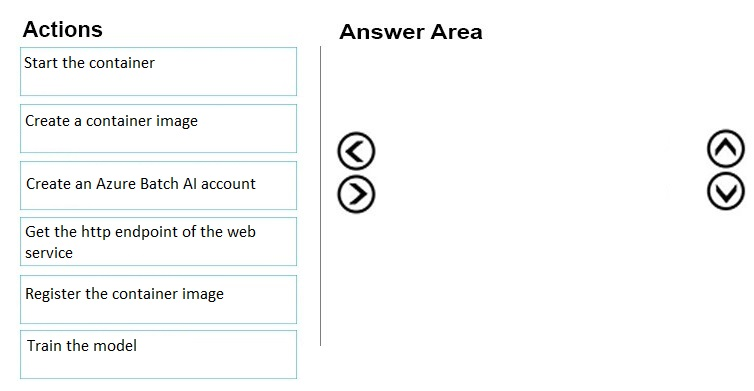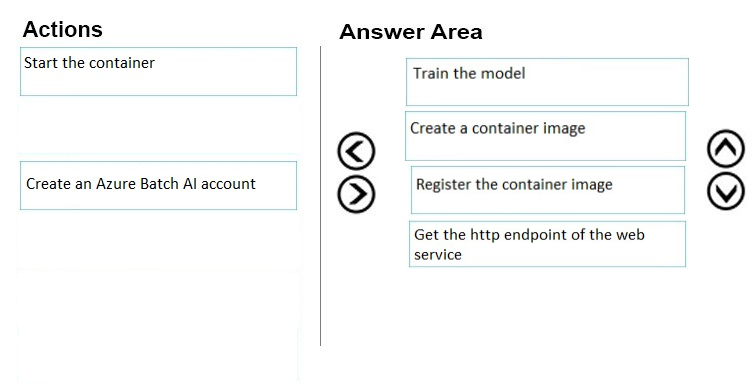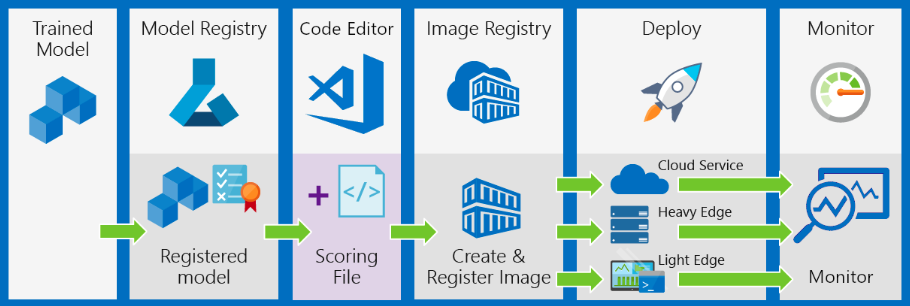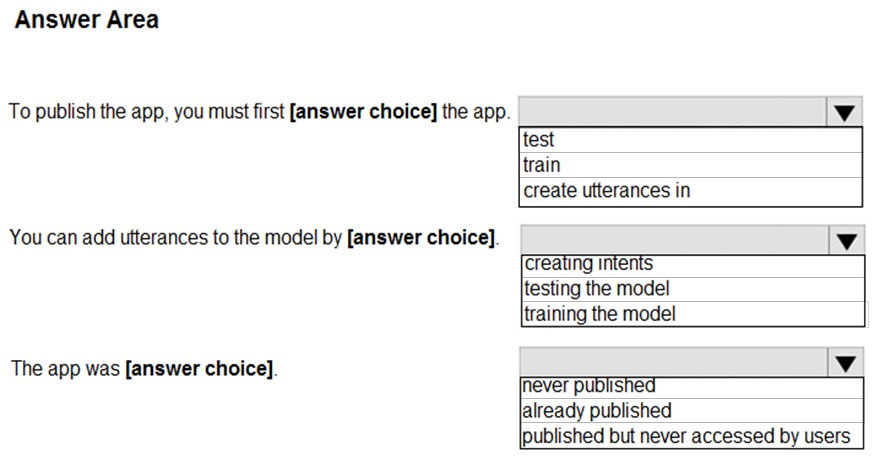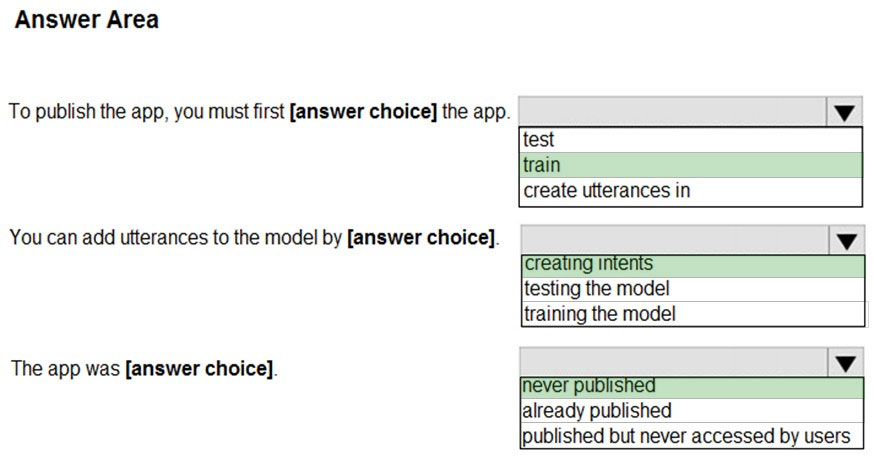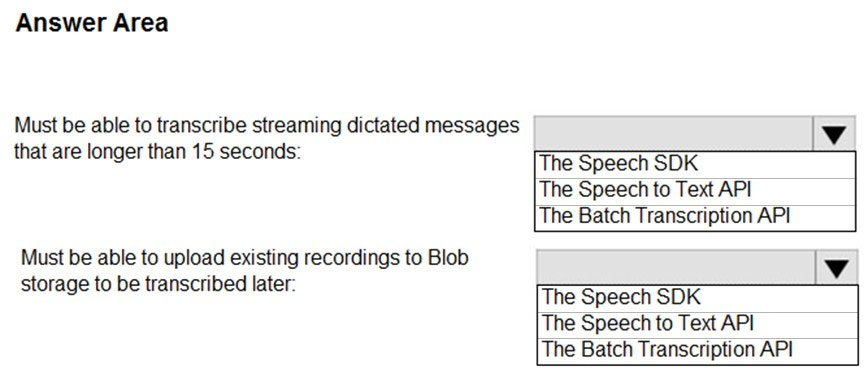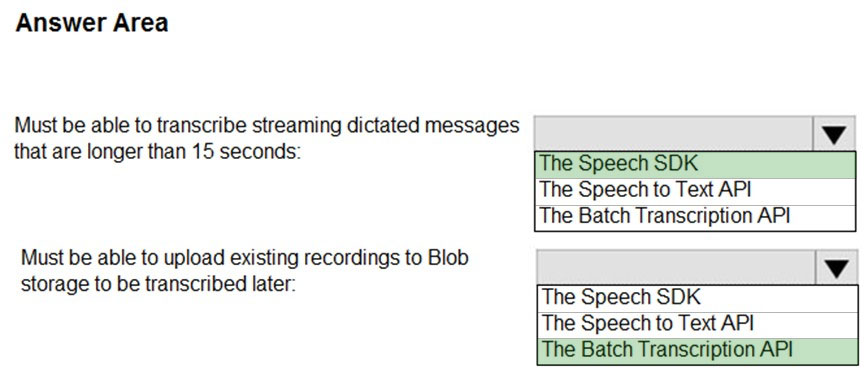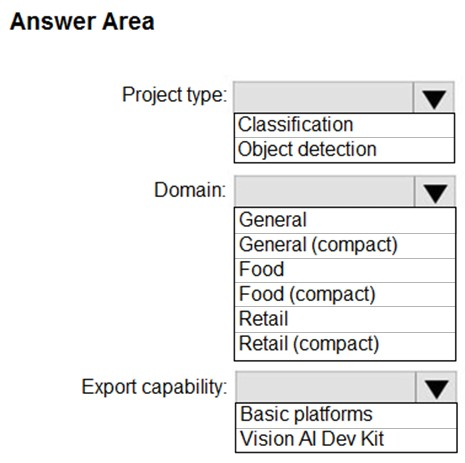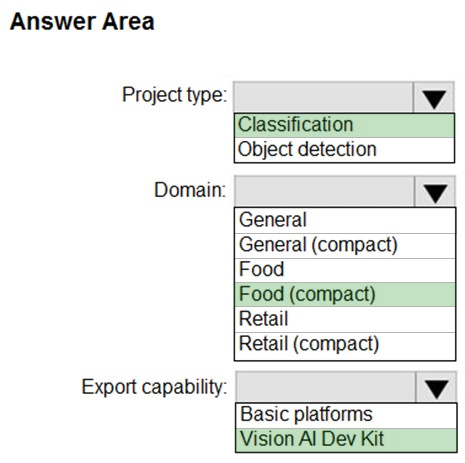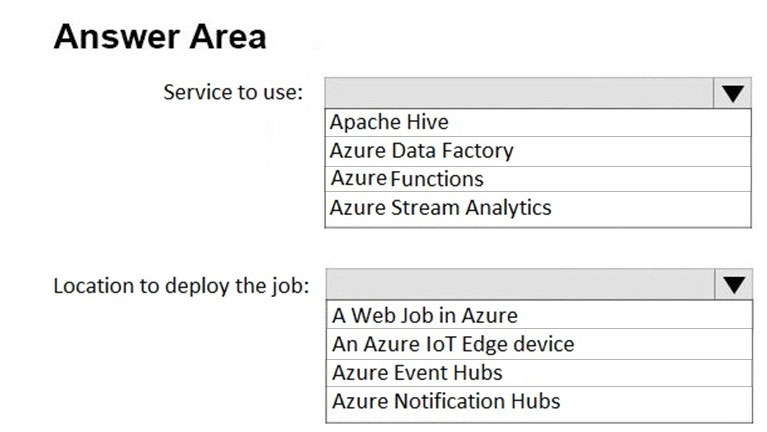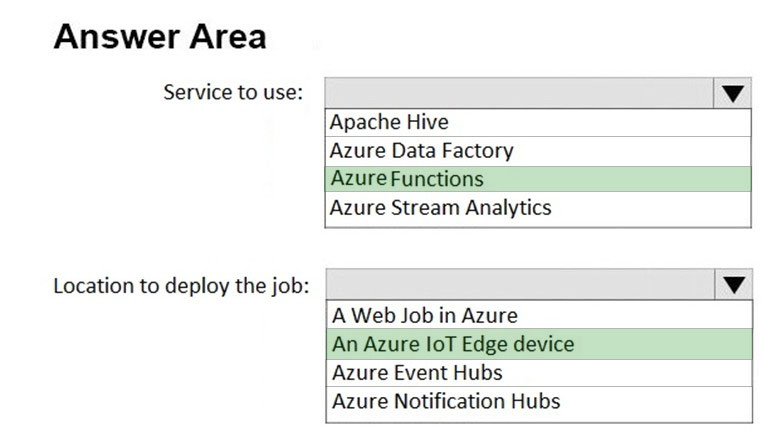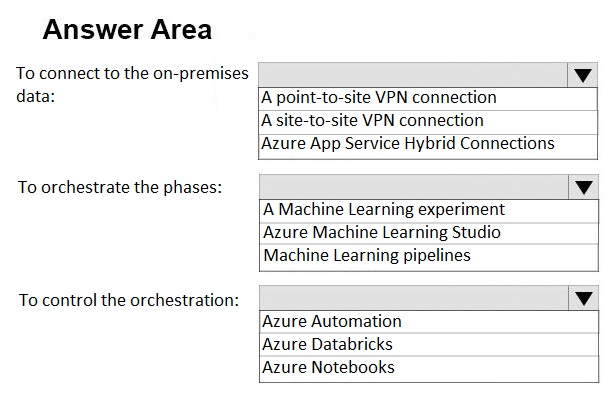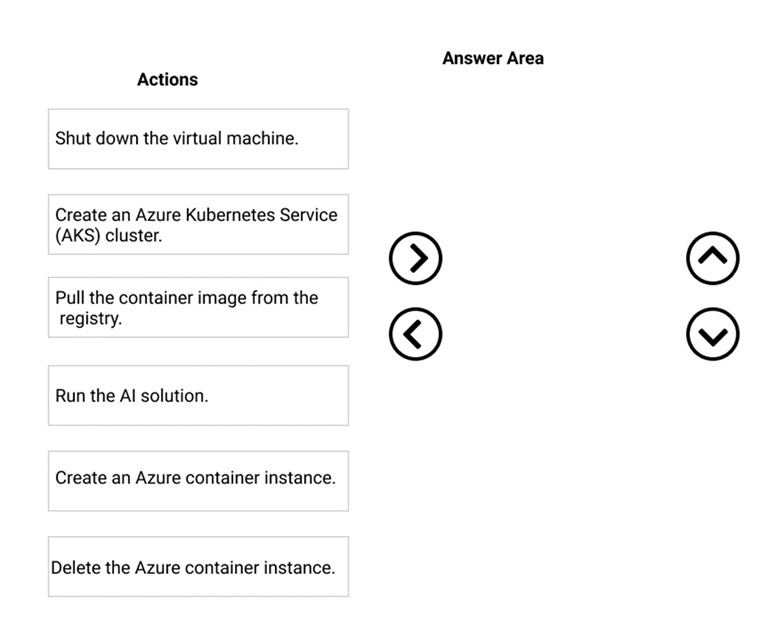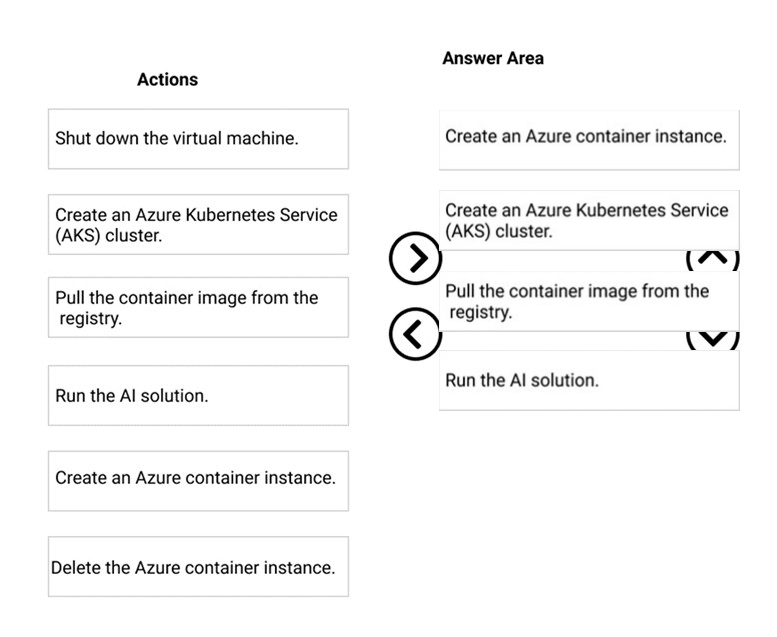AI-100 Exam Prep Free – 50 Practice Questions to Get You Ready for Exam Day
Getting ready for the AI-100 certification? Our AI-100 Exam Prep Free resource includes 50 exam-style questions designed to help you practice effectively and feel confident on test day
Effective AI-100 exam prep free is the key to success. With our free practice questions, you can:
- Get familiar with exam format and question style
- Identify which topics you’ve mastered—and which need more review
- Boost your confidence and reduce exam anxiety
Below, you will find 50 realistic AI-100 Exam Prep Free questions that cover key exam topics. These questions are designed to reflect the structure and challenge level of the actual exam, making them perfect for your study routine.
DRAG DROP - You create an image classification model in Azure Machine Learning Studio. You need to deploy the model as a containerized web service. Which four actions should you perform in sequence? To answer, move the appropriate actions from the list of actions to the answer area and arrange them in the correct order. Select and Place:
Your company has several AI solutions and bots. You need to implement a solution to monitor the utilization of the bots. The solution must ensure that analysts at the company can generate dashboards to review the utilization. What should you include in the solution?
A. Azure Application Insights
B. Azure Data Explorer
C. Azure Logic Apps
D. Azure Monitor
You are designing an AI solution that will analyze millions of pictures by using Azure HDInsight Hadoop cluster. You need to recommend a solution for storing the pictures. The solution must minimize costs. Which storage solution should you recommend?
A. Azure Table storage
B. Azure File Storage
C. Azure Data Lake Storage Gen2
D. Azure Databricks File System
You are designing an AI solution in Azure that will perform image classification. You need to identify which processing platform will provide you with the ability to update the logic over time. The solution must have the lowest latency for inferencing without having to batch. Which compute target should you identify?
A. graphics processing units (GPUs)
B. field-programmable gate arrays (FPGAs)
C. central processing units (CPUs)
D. application-specific integrated circuits (ASICs)
You are developing a bot for an ecommerce application. The bot will support five languages. The bot will use Language Understanding (LUIS) to detect the language of the customer, and QnA Maker to answer common customer questions. LUIS supports all the languages. You need to determine the minimum number of Azure resources that you must create for the bot. You create one instance of QnA Maker and five instances Language Understanding (LUIS). Does this action accomplish your objective?
A. Yes, it does
B. No, it does not
Your company is developing an AI solution that will identify inappropriate text in multiple languages. You need to implement a Cognitive Services API that meets this requirement. You use the Text Analytics API to identify inappropriate text. Does this action accomplish your objective?
A. Yes, it does
B. No, it does not
You have Azure IoT Edge devices that collect measurements every 30 seconds. You plan to send the measurements to an Azure IoT hub. You need to process events in the cloud and account for missing data. What should you use?
A. Apache Kafka
B. Azure Stream Analytics record functions
C. Azure Stream Analytics windowing functions
D. Azure Machine Learning on the IoT Edge devices
You are using the Text Analytics service to create an AI system that analyses documents. You want to implement a natural language processing workload that will be able to recognize the important points used in the documents. Which of the following actions should you take?
A. Make use of Language Understanding (LUIS)
B. Make use of Key phrase extraction
C. Make use of Document categorization
D. Make use of Anomaly detection
You design an AI solution that uses an Azure Stream Analytics job to process data from an Azure IoT hub. The IoT hub receives time series data from thousands of IoT devices at a factory. The job outputs millions of messages per second. Different applications consume the messages as they are available. The messages must be purged. You need to choose an output type for the job. What is the best output type to achieve the goal? More than one answer choice may achieve the goal.
A. Azure Event Hubs
B. Azure SQL Database
C. Azure Blob storage
D. Azure Cosmos DB
You are developing a mobile application that will perform optical character recognition (OCR) from photos. The application will annotate the photos by using metadata, store the photos in Azure Blob storage, and then score the photos by using an Azure Machine Learning model. What should you use to process the data?
A. Azure Event Hubs
B. Azure Functions
C. Azure Stream Analytics
D. Azure Batch
You have a Bing Search service that is used to query a product catalog. You need to identify the following information: ✑ The locale of the query ✑ The top 50 query strings ✑ The number of calls to the service ✑ The top geographical regions of the service What should you implement?
A. Bing Statistics
B. Azure API Management (APIM)
C. Azure Monitor
D. Azure Application Insights
Your company develops an API application that is orchestrated by using Kubernetes. You need to deploy the application. Which three actions should you perform? Each correct answer presents part of the solution. NOTE: Each correct selection is worth one point.
A. Create a Kubernetes cluster.
B. Create an Azure Container Registry instance.
C. Create a container image file.
D. Create a Web App for Containers.
E. Create an Azure container instance.
HOTSPOT - You have an app that uses the Language Understanding (LUIS) API as shown in the following exhibit.Use the drop-down menus to select the answer choice that completes each statement based on the information presented in the graphic. NOTE: Each correct selection is worth one point. Hot Area:
You plan to deploy a bot that will use the following Azure Cognitive Services: ✑ Language Understanding (LUIS) ✑ Text Analytics Your company's compliance policy states that all data used by the bot must be stored in the on-premises network. You need to recommend a compute solution to support the planned bot. What should you include in the recommendation?
A. an Azure Databricks cluster
B. a Docker container
C. Microsoft Machine Learning Server
D. the Azure Machine Learning service
You company's developers have created an Azure Data Factory pipeline that moves data from an on-premises server to Azure Storage. The pipeline consumes Azure Cognitive Services APIs. You need to deploy the pipeline. Your solution must minimize custom code. You use Integration Runtime to move data to the cloud and Azure API Management to consume Cognitive Services APIs. Does this action accomplish your objective?
A. Yes, it does
B. No, it does not
You plan to design an application that will use data from Azure Data Lake and perform sentiment analysis by using Azure Machine Learning algorithms. The developers of the application use a mix of Windows- and Linux-based environments. The developers contribute to shared GitHub repositories. You need all the developers to use the same tool to develop the application. What is the best tool to use? More than one answer choice may achieve the goal.
A. Microsoft Visual Studio Code
B. Azure Notebooks
C. Azure Machine Learning Studio
D. Microsoft Visual Studio
DRAG DROP - You are developing an application for photo classification. Users of the application will include minors. The users will upload photos to the application. The photos will be stored for model training purposes. All the photos must be considered appropriate for minors. You need to recommend an architecture for the application. Which Azure services should you recommend using in the architecture? To answer, drag the appropriate services to the correct targets. Each service may be used once, more than once, or not at all. You may need to drag the split bar between panes or scroll to view content. NOTE: Each correct selection is worth one point. Select and Place:
You create an Azure Cognitive Services resource. A developer needs to be able to retrieve the keys used by the resource. The solution must use the principle of least privilege. What is the best role to assign to the developer?
A. Security Manager
B. Security Reader
C. Cognitive Services Contributor
D. Cognitive Services User
You are designing an Azure Batch AI solution that will perform image recognition. The solution will be used to train several Azure Machine Learning models. You need to enable versioning for Azure Machine Learning models. What should you do?
A. Register the Azure Machine Learning models.
B. Use Azure HDInsight cluster.
C. Use Machine Learning experiments.
D. Use Machine Learning pipelines.
HOTSPOT - You plan to build an app that will provide users with the ability to dictate messages and convert the messages into text. You need to recommend a solution to meet the following requirements for the app: ✑ Must be able to transcribe streaming dictated messages that are longer than 15 seconds. ✑ Must be able to upload existing recordings to Azure Blob storage to be transcribed later. Which solution should you recommend for each requirement? To answer, select the appropriate options in the answer area. NOTE: Each correct selection is worth one point. Hot Area:
HOTSPOT - You are designing a Custom Vision Service solution to identify perishable products in grocery stores. The solution will be deployed as part of a mobile app. You need to recommend the configurations for the Custom Vision API. The solution must minimize the size of the mobile app. What should you recommend? To answer, select the appropriate options in the answer area. NOTE: Each correct selection is worth one point. Hot Area:
After you answer a question, you will NOT be able to return to it. As a result, these questions will not appear in the review screen. You have an Azure SQL database, an Azure Data Lake Storage Gen 2 account, and an API developed by using Azure Machine Learning Studio. You need to ingest data once daily from the database, score each row by using the API, and write the data to the storage account. Solution: You create an Azure Data Factory pipeline that contains the Machine Learning Batch Execution activity. Does this meet the goal?
A. Yes
B. No
You are developing an AI application for your company. The application will use Microsoft Azure Stream Analytics. You save the outputs from the Stream Analytics workflows to the cloud. Which of the following actions should you take?
A. Make use of a Hive table in Azure HDInsight
B. Make use of Azure Cosmos DB
C. Make use of Azure File storage
D. Make use of Azure Table storage
Your company recently deployed several hardware devices that contain sensors. The sensors generate new data on an hourly basis. The data generated is stored on-premises and retained for several years. During the past two months, the sensors generated 300 GB of data. You plan to move the data to Azure and then perform advanced analytics on the data. You need to recommend an Azure storage solution for the data. Which storage solution should you recommend?
A. Azure Queue storage
B. Azure Cosmos DB
C. Azure Blob storage
D. Azure SQL Database
Which RBAC role should you assign to the KeyManagers group?
A. Cognitive Services Contributor
B. Security Manager
C. Cognitive Services User
D. Security Administrator
You have an Azure Machine Learning experiment. You need to validate that the experiment meets GDPR regulation requirements and stores documentation about the experiment. What should you use?
A. Compliance Manager
B. an Azure Log Analytics workspace
C. Azure Table storage
D. Azure Security Center
After you answer a question, you will NOT be able to return to it. As a result, these questions will not appear in the review screen. You are developing an application that uses an Azure Kubernetes Service (AKS) cluster. You are troubleshooting a node issue. You need to connect to an AKS node by using SSH. Solution: You add an SSH key to the node, and then you create an SSH connection. Does this meet the goal?
A. Yes
B. No
You need to build an API pipeline that analyzes streaming data. The pipeline will perform the following: ✑ Visual text recognition ✑ Audio transcription ✑ Sentiment analysis ✑ Face detection Which Azure Cognitive Services should you use in the pipeline?
A. Custom Speech Service
B. Face API
C. Text Analytics
D. Video Indexer
You plan to implement a new data warehouse for a planned AI solution. You have the following information regarding the data warehouse: ✑ The data files will be available in one week. ✑ Most queries that will be executed against the data warehouse will be ad-hoc queries. ✑ The schemas of data files that will be loaded to the data warehouse will change often. ✑ One month after the planned implementation, the data warehouse will contain 15 TB of data. You need to recommend a database solution to support the planned implementation. What two solutions should you include in the recommendation? Each correct answer is a complete solution. NOTE: Each correct selection is worth one point.
A. Apache Hadoop
B. Apache Spark
C. A Microsoft Azure SQL database
D. An Azure virtual machine that runs Microsoft SQL Server
Your company is building custom models that integrate into microservices architecture on Azure Kubernetes Services (AKS). The model is built by using Python and published to AKS. You need to update the model and enable Azure Application Insights for the model. What should you use?
A. the Azure CLI
B. MLNET Model Builder
C. the Azure Machine Learning SDK
D. the Azure portal
You have deployed several Azure IoT Edge devices for an AI solution. The Azure IoT Edge devices generate measurement data from temperature sensors. You need a solution to process the sensor data. Your solution must be able to write configuration changes back to the devices. You make use of Microsoft Azure IoT Hub. Does this action accomplish your objective?
A. Yes, it does
B. No, it does not
You are developing an AI application for your company. The application that uses batch processing to analyze data in JSON and PDF documents. You want to store the JSON and PDF documents in Azure. You want to ensure data persistence while keeping costs at a minimum. Which of the following actions should you take?
A. Make use of Azure Blob storage
B. Make use of Azure Cosmos DB
C. Make use of Azure Databricks
D. Make use of Azure Table storage
After you answer a question, you will NOT be able to return to it. As a result, these questions will not appear in the review screen. You need to create an IoT solution that performs the following tasks: ✑ Identifies hazards ✑ Provides a real-time online dashboard ✑ Takes images of an area every minute ✑ Counts the number of people in an area every minute Solution: You configure the IoT devices to send the images to an Azure IoT hub, and then you configure an Azure Automation call to Azure Cognitive Services that sends the results to an Azure event hub. You configure Microsoft Power BI to connect to the event hub by using Azure Stream Analytics. Does this meet the goal?
A. Yes
B. No
Your plan to design a bot that will be hosted by using Azure Bot Service. Your company identifies the following compliance requirements for the bot: ✑ Payment Card Industry Data Security Standards (PCI DSS) ✑ General Data Protection Regulation (GDPR) ✑ ISO 27001 You need to identify which compliance requirements are met by hosting the bot in the bot service. What should you identify?
A. PCI DSS only
B. PCI DSS, ISO 27001, and GDPR
C. ISO 27001 only
D. GDPR only
Your company has recently purchased and deployed 25,000 IoT devices. You need to recommend a data analysis solution for the devices that meets the following requirements: ✑ Each device must use its own credentials for identity. ✑ Each device must be able to route data to multiple endpoints. ✑ The solution must require the minimum amount of customized code. What should you include in the recommendation?
A. Microsoft Azure Notification Hubs
B. Microsoft Azure Event Hubs
C. Microsoft Azure IoT Hub
D. Microsoft Azure Service Bus
HOTSPOT - You are designing a solution that will ingest temperature data from IoT devices, calculate the average temperature, and then take action based on the aggregated data. The solution must meet the following requirements: ✑ Minimize the amount of uploaded data. ✑ Take action based on the aggregated data as quickly as possible. What should you include in the solution? To answer, select the appropriate options in the answer area. NOTE: Each correct selection is worth one point. Hot Area:
You have an app that records meetings by using speech-to-text capabilities from the Speech Services API. You discover that when action items are listed at the end of each meeting, the app transcribes the text inaccurately when industry terms are used. You need to improve the accuracy of the meeting records. What should you do?
A. Add a phrase list
B. Create a custom wake word
C. Parse the text by using the Language Understanding (LUIS) API
D. Train a custom model by using Custom Translator
After you answer a question, you will NOT be able to return to it. As a result, these questions will not appear in the review screen. You are developing an application that uses an Azure Kubernetes Service (AKS) cluster. You are troubleshooting a node issue. You need to connect to an AKS node by using SSH. Solution: You run the kubect1 command, and then you create an SSH connection. Does this meet the goal?
A. Yes
B. No
HOTSPOT - You are designing an Azure infrastructure to support an Azure Machine Learning solution that will have multiple phases. The solution must meet the following requirements: ✑ Securely query an on-premises database once a week to update product lists. ✑ Access the data without using a gateway. ✑ Orchestrate the separate phases. What should you use? To answer, select the appropriate options in the answer area. NOTE: Each correct selection is worth one point. Hot Area:
You plan to deploy Azure IoT Edge devices that will each store more than 10,000 images locally and classify the images by using a Custom Vision Service classifier. Each image is approximately 5 MB. You need to ensure that the images persist on the devices for 14 days. What should you use?
A. The device cache
B. Azure Blob storage on the IoT Edge devices
C. Azure Stream Analytics on the IoT Esge devices
D. Microsoft SQL Server on the IoT Edge devices
DRAG DROP - You have a container image that contains an AI solution. The solution will be used on demand and will only be needed a few hours each month. You plan to use Azure Functions to deploy the environment on-demand. You need to recommend the deployment process. The solution must minimize costs. Which four actions should you recommend Azure Functions perform in sequence? To answer, move the appropriate actions from the list of actions to the answer area and arrange them in the correct order. Select and Place:
Your company uses an internal blog to share news with employees. You use the Translator Text API to translate the text in the blog from English to several other languages used by the employees. Several employees report that the translations are often inaccurate. You need to improve the accuracy of the translations. What should you add to the translation solution?
A. Text Analytics
B. Language Understanding (LUIS)
C. Azure Media Services
D. Custom Translator
Your company creates a popular mobile game. The company tracks usage patterns of the game. You need to provide special offers to users when there is a significant change in the usage patterns. Which Azure Cognitive Services service should you use?
A. Form Recognizer
B. Bing Autosuggest
C. Text Analytics
D. Anomaly Detector
You are designing a Computer Vision AI application. You need to recommend a deployment solution for the application. The solution must ensure that costs scale linearly without any upfront costs. What should you recommend?
A. a containerized Computer Vision API on Azure Kubernetes Service (AKS) that has autoscaling configured
B. the Computer Vision API as a single resource
C. an Azure Container Service
D. a containerized Computer Vision API on Azure Kubernetes Service (AKS) that has virtual nodes configured
After you answer a question, you will NOT be able to return to it. As a result, these questions will not appear in the review screen. You are developing an application that uses an Azure Kubernetes Service (AKS) cluster. You are troubleshooting a node issue. You need to connect to an AKS node by using SSH. Solution: You change the permissions of the AKS resource group, and then you create an SSH connection. Does this meet the goal?
A. Yes
B. No
You are developing a Microsoft Bot Framework application. The application consumes structured NoSQL data that must be stored in the cloud. You implement Azure Blob storage for the application. You want access to the blob store to be controlled by using a role. You implement Shared Access Signatures (SAS) on the storage account. Does this action accomplish your objective?
A. Yes, it does
B. No, it does not
DRAG DROP - You need to build an AI solution that will be shared between several developers and customers. You plan to write code, host code, and document the runtime all within a single user experience. You build the environment to host the solution. Which three actions should you perform in sequence next? To answer, move the appropriate actions from the list of actions to the answer area and arrange them in the correct order. Select and Place:
You have an SAP production landscape. You plan to use Azure Machine Learning to develop a fraud detection API. The API will identify potentially fraudulent transactions in the SAP production landscape in near real time. You need to recommend a workflow for the API. What should you recommend?
A. an Azure Data Factory pipeline that uses an SAP table connector and a Machine Learning Execute Pipeline activity
B. a Microsoft Excel workbook that imports SAP transactions and uses the Excel add-in for web services to score the transactions
C. an Azure logic app triggered by an SAP message that calls the API and sends an email based on the results
D. a scheduled Jupyter Notebook in Azure Databricks that connects to SAP HANA
You plan to build an application that will perform predictive analytics. Users will be able to consume the application data by using Microsoft Power BI or a custom website. You need to ensure that you can audit application usage. Which auditing solution should you use?
A. Azure Storage Analytics
B. Azure Application Insights
C. Azure diagnostics logs
D. Azure Active Directory (Azure AD) reporting
You are using Azure Cognitive Services to create an interactive AI application that will be deployed for a world-wide audience. You want the app to support multiple languages, including English, French, Spanish, Portuguese, and German. Which of the following actions should you take?
A. Make use of Text Analytics.
B. Make use of Content Moderator.
C. Make use of QnA Maker.
D. Make use of Language API.
Access Full AI-100 Exam Prep Free
Want to go beyond these 50 questions? Click here to unlock a full set of AI-100 exam prep free questions covering every domain tested on the exam.
We continuously update our content to ensure you have the most current and effective prep materials.
Good luck with your AI-100 certification journey!


